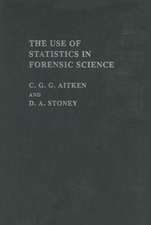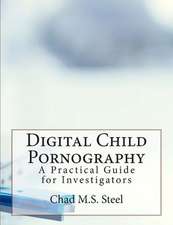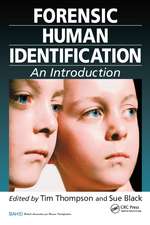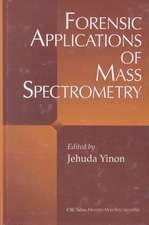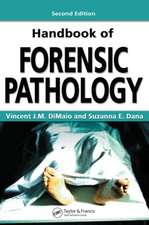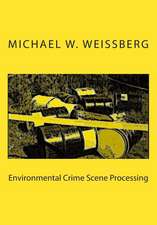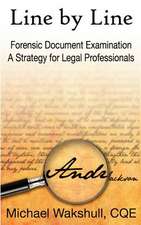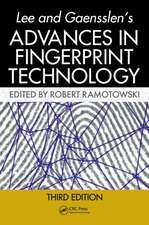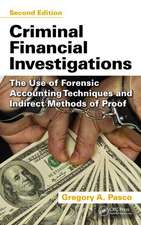Forensic Anthropology: 2000 to 2010
Editat de Sue Black, Eilidh Fergusonen Limba Engleză Paperback – 7 feb 2011
Topics discussed include:
- Age determination in juveniles and adults
- Sex, race, and ancestry determination
- Stature determination
- Dental and facial identification
- Skeletal trauma and bone pathology
- Taphonomy and comparative osteology
- Identification from soft tissues
Preț: 794.16 lei
Preț vechi: 968.49 lei
-18% Nou
Puncte Express: 1191
Preț estimativ în valută:
151.96€ • 158.67$ • 125.48£
151.96€ • 158.67$ • 125.48£
Carte tipărită la comandă
Livrare economică 15-29 aprilie
Preluare comenzi: 021 569.72.76
Specificații
ISBN-13: 9781439845882
ISBN-10: 1439845883
Pagini: 428
Ilustrații: 3 black & white tables
Dimensiuni: 156 x 234 x 23 mm
Greutate: 0.79 kg
Ediția:1
Editura: Taylor & Francis
Colecția CRC Press
Locul publicării:Oxford, United Kingdom
ISBN-10: 1439845883
Pagini: 428
Ilustrații: 3 black & white tables
Dimensiuni: 156 x 234 x 23 mm
Greutate: 0.79 kg
Ediția:1
Editura: Taylor & Francis
Colecția CRC Press
Locul publicării:Oxford, United Kingdom
Public țintă
Academic and Professional Practice & DevelopmentCuprins
Age Determination in the Juvenile. Age Determination in the Adult. Sex Determination. Stature. Race and Ancestry. Dental Identification. Skeletal Trauma. Bone Pathology. Taphonomy. Comparative Osteology. Identification from Soft Tissues. Facial Identification of the Dead. Index.
Recenzii
Forensic Anthropology: 2000 to 2010 is an edited text produced by members of the Centre for Anatomy and Human Identification at the University of Dundee. All major aspects of the subject are covered in the 12 chapters, each of which provide a brief summary and then, most valuably, continued with a list of references published during the last ten years on each topic. Each chapter was initially written by honours students in forensic anthropology and then revised and edited with the cooperation of a specialist member of staff. Thus this is an extremely useful edited reference text, written largely by students, for students, who need up-to-date information for their studies in Forensic Anthropology.
—Louise Scheuer, Forensic Anthropologist and Honorary Chair, University of Dundee, and co-author of Developmental Juvenile Osteology
" … a carefully conceived, clearly organized, and well-executed volume. … the scope and diversity of references make Forensic Anthropology 2000 to 2010 a valuable resource for everyone in this field. … Whether your goal is to conduct research, look up a technique to use in a forensic case, or brush up on the latest developments in a particular area of forensic anthropology, this edited volume provides a quick and easy means of finding current and relevant information about lab-based forensic anthropology."
— Tracy L. Rogers, Ph.D., Department of Anthropology and Forensic Science Program, University of Toronto Mississauga, Ontario, Canada, in Canadian Society of Forensic Science Journal
"This book will make a welcome addition to the forensic anthropology literature. It contains short and concise chapters with extensive referencing. … will no doubt be of use to both the student and the professional."
—Bernadette Manifold, Forensic Science, Medicine, and Pathology
—Louise Scheuer, Forensic Anthropologist and Honorary Chair, University of Dundee, and co-author of Developmental Juvenile Osteology
" … a carefully conceived, clearly organized, and well-executed volume. … the scope and diversity of references make Forensic Anthropology 2000 to 2010 a valuable resource for everyone in this field. … Whether your goal is to conduct research, look up a technique to use in a forensic case, or brush up on the latest developments in a particular area of forensic anthropology, this edited volume provides a quick and easy means of finding current and relevant information about lab-based forensic anthropology."
— Tracy L. Rogers, Ph.D., Department of Anthropology and Forensic Science Program, University of Toronto Mississauga, Ontario, Canada, in Canadian Society of Forensic Science Journal
"This book will make a welcome addition to the forensic anthropology literature. It contains short and concise chapters with extensive referencing. … will no doubt be of use to both the student and the professional."
—Bernadette Manifold, Forensic Science, Medicine, and Pathology
Notă biografică
Sue Black is a professor of anatomy and forensic anthropology and director of the Centre for Anatomy and Human Identification at the University of Dundee. She is a founder and director of the Centre for International Forensic Assistance (CIFA), founder and past president of the British Association for Human Identification, and advisor to the Home Office on issues pertaining to disaster victim identification (DVI). She is a Fellow of the Royal Society of Edinburgh, a Fellow of the Royal Anthropological Institute, and an honorary Fellow of the Royal College of Physicians and Surgeons of Glasgow. She was awarded an Order of the British Empire (OBE) in 2001 for her services to forensic anthropology in Kosovo, the Lucy Mair medal for humanitarian services in anthropology, and a police commendation in 2008 for DVI training.
Eilidh Ferguson was nominated to be coeditor for this text by her student peers. She graduated with a first-class honours bachelor of science degree in forensic anthropology from the Centre for Anatomy and Human Identification at the University of Dundee. Eilidh served as class representative during her period of study at the university, and this is her first venture into publications.
Eilidh Ferguson was nominated to be coeditor for this text by her student peers. She graduated with a first-class honours bachelor of science degree in forensic anthropology from the Centre for Anatomy and Human Identification at the University of Dundee. Eilidh served as class representative during her period of study at the university, and this is her first venture into publications.
Descriere
Advances in our ability to analyse information from skeletal remains and subsequent developments in the field of forensic anthropology make it possible to identify more victims of homicides, mass-fatality disasters, and genocide. Summarizing the vast collection of international literature that has developed over the past decade, this volume explores critical themes fundamental to this evolving discipline. Topics discussed include age determination in juveniles and adults; sex, race, and ancestry determination; stature determination; dental and facial identification; skeletal trauma and bone pathology; taphonomy and comparative osteology; and identification from soft tissues.

